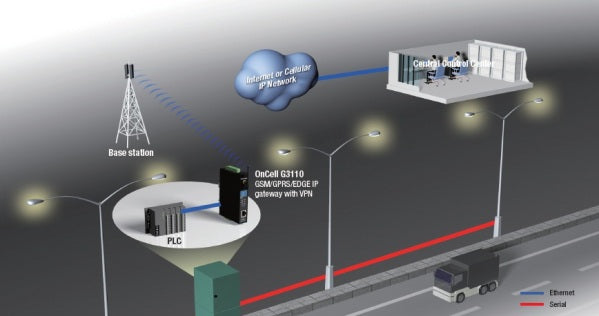Overview
Public lighting systems play an essential role in protecting the safety of pedestrians and drivers in any major city. However, maintaining a city-wide network of street lamps requires a great deal of energy and financial costs. Moreover, leaving street lights on for too long negatively impacts the environment. As a result, street light control systems for public lighting networks have become a popular solution for municipal governments to reduce energy consumption and curtail expanding budget deficits. System functionality includes controlling a circuit of street lights and/or individual lights with specific ballasts and network operating protocols. Looking to reduce energy consumption, one of the largest cities in the European Union came to Moxa to help implement a cost-effective control system for its municipal lighting system.
System Requirements
• The city required a solution that is both easily scalable to accommodate future growth, and also able to reduce overall maintenance and energy costs.
• The solution must enable operators at the central control centre to not only turn the street lamps ON and OFF, but also to monitor weather conditions and climate changes.
• Provide reliable performance and secured connections for serial-interface programmable logic controllers (PLC) to control each municipal street light.
Solution
A programmable logic controller, or PLC, is connected to each lamp post to turn the street lamp ON and OFF. Since the PLCs used a serial interface, the city needed a way to control and monitor their entire system from a remote control centre. As cellular GSM/GPRS/EDGE networks already provide abundant coverage throughout Spain, Moxa decided to equip all the street lights with cellular connectivity to take advantage of the existing infrastructure in place. That way, the city not only saved money on additional wiring costs, but also saved on future maintenance. The OnCell G3150 connects Ethernet and serial devices over an integrated VPN. In addition, by connecting the PLC for each street light to an OnCell G3150 cellular IP gateway, computers at the control centre could easily monitor and control the city’s street lights over the Internet and optimize usage according to weather conditions.
Delivery | Can I select a specific time for delivery?
Delivery | Can I select a specific time for delivery?
We are unable to allocate a specific time for delivery. You may let us know your preferred timing and we will try our best to meet your request if possible.
Delivery | Do you have self collection option for urgent request?
Delivery | Do you have self collection option for urgent request?
Yes, for urgent purchases, please contact TNS before placing your order
Delivery | Do you provide International Shipping?
Delivery | Do you provide International Shipping?
Yes, TNS offers international shipping out of Singapore. Our delivery partners are Fedex and DHL. Product prices quoted on our website is in Singapore currency by default.
Delivery | Is there free delivery service?
Delivery | Is there free delivery service?
Enjoy free local delivery service for online order over S$80. Free delivery service is within Singapore mainland (excluding Jurong Island, shipyards and restricted locations).
Purchase | Can I use my nickname or alias when placing my order?
Purchase | Can I use my nickname or alias when placing my order?
To ensure the safe delivery of your order, it is recommended to indicate your full name that matches your valid identification document (ID).
Purchase | What is the minimum order?
Purchase | What is the minimum order?
Unless specified, there is no minimum order.
Purchase | What payment methods do you accept?
Purchase | What payment methods do you accept?
TNS accepts payment via credit card, paynow transfer, cash and funds wired to our bank.
Support | Do I need to register for product warranty?
Support | Do I need to register for product warranty?
No registration is necessary. Your product is registered at the time of purchase.
Support | How do I configure/use/troubleshoot Moxa & Axiomtek products?
Support | How do I configure/use/troubleshoot Moxa & Axiomtek products?
TNS offers advice on product configuration and technical support. Our support hotline +65-67476740 is open from 9am to 5.30pm on weekdays. You can also email your questions to us.
This product is export-ready and classified under an international HS Code for smooth customs clearance. TNS ships worldwide via DHL Express, providing fast and reliable international delivery.
For customers in Singapore, we offer free local shipping on orders above SGD $80 — no extra handling fees.
Below are key shipping and compliance details to support both local and international logistics planning.






